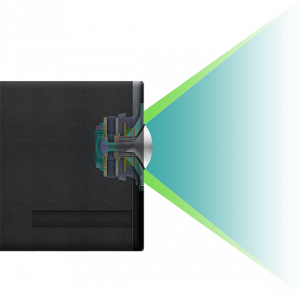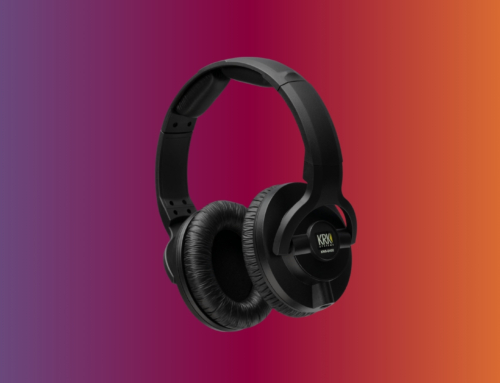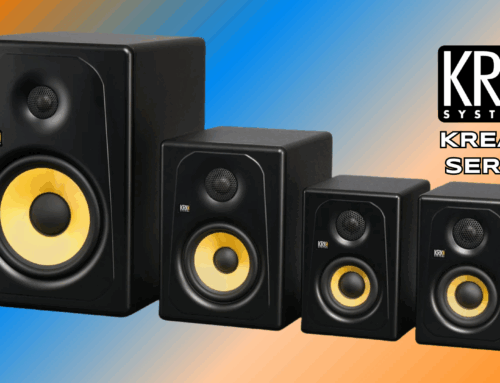The PreSonus Sceptre S8 is an extension of what S6 has to offer. It has a bigger woofer diameter and enclosure size then its smaller sibling. Numerous reports and testimonials have endorsed these speakers and almost every customer review contains the words “clear” and “pure”, and that’s not a coincidence.
Sceptre 8 have made quite some noise, due to the quality that the product has delivered. These babies feature a complicated coaxial design so that the user can perceive the slightest shifts and changes in equalisation at any moment in time. Each monitor features a 8-inch low frequency speaker and a 1-inch high frequency in the above-mentioned coaxial configuration. And they can get fairly loud too. Each speaker is amplified with 180W and has its own internal heat sink and power supply. Now, speaking of design, there is certainly a price to pay and we’re particularly speaking of the size and weight. First off, 11 kilos per monitor is quite hefty and their size is quite mentionable: 290mm width, 300mm diameter and a height of 400mm.
 Now the above-mentioned coaxial design has been quite a challenging aspect of monitor and speaker manufacturers. The single point source provided by coaxial designs offers unique advantages, thanks to their consistent acoustic center and symmetrical dispersion pattern. The proprietary CoActual design in the Sceptre S8 relies on custom coaxial drivers and advanced onboard DSP to create a seamless crossover transition and an even frequency response. The net result is exceptional 3D imaging and a natural listening experience that reveals the subtlest details. For quite a while coaxial-design monitors cost big bucks, but PreSonus appears to have relatively solved this issue, bringing the price down to $599.95 per speaker, whereas normally coaxial monitors would double and sometimes triple the price.
Now the above-mentioned coaxial design has been quite a challenging aspect of monitor and speaker manufacturers. The single point source provided by coaxial designs offers unique advantages, thanks to their consistent acoustic center and symmetrical dispersion pattern. The proprietary CoActual design in the Sceptre S8 relies on custom coaxial drivers and advanced onboard DSP to create a seamless crossover transition and an even frequency response. The net result is exceptional 3D imaging and a natural listening experience that reveals the subtlest details. For quite a while coaxial-design monitors cost big bucks, but PreSonus appears to have relatively solved this issue, bringing the price down to $599.95 per speaker, whereas normally coaxial monitors would double and sometimes triple the price.
PreSonus Sceptre speakers incorporate Fulcrum Acoustics’ TQ™ Temporal Equalization algorithms. TQ employs multiple, fully addressable Finite Impulse Response (FIR) filters to eliminate horn reflections and to correct linear time and amplitude anomalies. Collaborating with Fulcrum Acoustics’ co-founder, Dave Gunness, PreSonus software designers incorporated custom TQ algorithms with dynamics processing, FFT tools, and performance monitoring into the onboard DSP—quite possibly the most powerful suite of tools ever available in a studio monitor. Also the DSP can be tweaked so that the output perfectly fits the environment you are in.

Each speaker can achieve a whopping 102dB of maximum continuous Sound Pressure Level (SPL). The bass is deep and punchy in the S8’s and their mids are ‘flat’, however in a definitely good way. And flat may not be a great term because flat refers to the accuracy of a speaker’s frequency response. Expressed as a graph, with frequency (Hz) on the x axis and sound pressure level (dB) on the y axis, if the incoming electrical signal and the speaker’s measured output match exactly, the frequency response graph will be flat, indicating that the speaker is perfectly accurate. Now, no speaker is perfectly accurate throughout the frequency spectrum, but the S8’s response is indeed impressive.

Another cool feature you’ll find on board is the over-heating protection. Also there’s the soft startup. The soft startup feature is intended to protect the speakers from those pops, which can damage your speakers. A practical aspect that some manufacturers did not yet implement in their products. And that’s absolutely criminal. Yet Sceptre features the above-mentioned soft startup.




